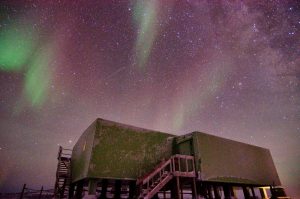25 July 2018
Research provides new clues to origins of mysterious atmospheric waves in Antarctica
Posted by Lauren Lipuma
Research team finds link between gravity waves in the upper and lower Antarctic atmosphere, helping create a clearer picture of global air circulation
By Katie Weeman
Two years after a research team discovered a previously unknown class of waves rippling continuously through the upper Antarctic atmosphere, they’ve uncovered tantalizing clues to the waves’ origins. The interdisciplinary science team’s work to understand the formation of “persistent gravity waves” promises to help researchers better understand connections between the layers of Earth’s atmosphere—helping form a more complete understanding of air circulation around the world.
“A big-picture of Antarctic gravity waves from the surface all the way to the thermosphere is emerging from the studies, which may help advance global atmospheric models,” said Xinzhao Chu, a fellow at the Cooperative Institute for Research in Environmental Science (CIRES) and professor of aerospace engineering sciences at the University of Colorado Boulder.
“The new understanding results from a series of journal publications, based on multiple years of lidar observations, many made by winter-over students, from Arrival Heights near McMurdo Station in Antarctica,” said Chu, who is lead author of a new study detailing the findings in the Journal of Geophysical Research: Atmospheres, a journal of the American Geophysical Union.

Arrival Heights lidar observations under aurora, hosted by Antarctica New Zealand and United States Antarctic Program.
Credit: Zhibin Yu.
In a 2016 paper, Chu and her colleagues discovered persistent gravity waves: huge ripples that sweep through the upper atmosphere in every 3 to 10 hours. And now, by combining observations, theory, and models, they propose two possible origins of those waves: they are either from lower-level waves breaking and re-exciting new waves higher in the sky and/or from polar vortex winds.
Since 2016, the team managed to track the origin of the upper atmospheric waves down to the lower-altitude stratosphere. The team then characterized the dominant gravity waves there, but found they had very different properties than the persistent waves in the upper atmosphere.
“The upper-atmosphere waves are huge, around 1,200 miles (2,000 kilometers), and the lower, stratospheric waves are much smaller—only 250 miles (400 kilometers),” said Jian Zhao, a Ph.D. candidate in CU Aerospace, working in Chu’s group, who stayed the 2015 winter over McMurdo for lidar observations.
Zhao and colleagues previously described the stratospheric waves in an earlier study, and he is second author on the new study which describes how the wave energy varies over seasons and years—documenting those kinds of variations is critical for researchers trying to understand how the waves influence things like global air circulation and climate change.
The team suspects that when these lower, smaller-scale stratospheric gravity waves break, they trigger the formation of the huge, upper-atmospheric waves through a process called “secondary wave generation.” Evidence from lidar data pointing to this pattern was described in a paper published this year.
“It’s similar to ocean waves breaking on a beach,” said Sharon Vadas, researcher from Northwest Research Associates who theorized the idea of the secondary wave generation. “When the wind flows downslope from the mountains near McMurdo, the excited mountain waves travel upward in the atmosphere, growing larger and larger until they break.”
Understanding the origins of the waves relied on Vadas’ theory of secondary gravity waves and a global, high-resolution model created by Erich Becker at the Leibniz Institute of Physics in Germany. Becker’s model perfectly stitches together the theory and lidar observations. It suggests that secondary wave formation is particularly persistent during winter, and that it occurs not only at McMurdo Station, but at mid to high latitudes in both hemispheres.
Another possible source of the persistent waves is the polar vortex—a persistent pattern of wind and weather that rotates around South Pole during winter, Chu and her colleagues reported in the latest paper.
“The fast vortex winds could either modify the waves as they move upward, or the winds could actually generate waves themselves,” said Lynn Harvey, a coauthor on the study, and researcher at the Laboratory for Atmospheric and Space Studies (LASP) at CU Boulder. “With more observations, we should be able to determine which scenario is true.”
Chu and her research colleagues sometimes find themselves sitting at desks running computer models and calculations, and sometimes they are bundled head-to-toe, walking through strong winds and frigid temperatures well-below zero degrees F in Antarctica to run cutting edge lidar systems installed there.
The National Science Foundation’s U.S. Antarctic Program and Antarctica New Zealand have supported the team’s work in Antarctica for eight years, starting with the installation of Chu’s custom-built lidar systems, which allows her team to probe the most difficult-to-observe regions of the atmosphere. Studying atmospheric waves near the South Pole is critical to improving climate and weather models, and forming a better picture of global atmospheric behavior.
“We still have many unanswered questions,” said Chu. “But in about five years, using a combination of observations and high-resolution modelling, we hope to resolve these mysteries.”
Two of her students will travel to Antarctica this October to continue the research.
— Katie Weeman is a communications assistant at CIRES and CU Boulder. This post originally appeared as a news story on the CIRES website.










 GeoSpace is a blog on Earth and space science, managed by AGU’s Public Information staff. The blog features posts by AGU writers and guest contributors on all sorts of relevant science topics, but with a focus on new research and geo and space sciences-related stories that are currently in the news.
GeoSpace is a blog on Earth and space science, managed by AGU’s Public Information staff. The blog features posts by AGU writers and guest contributors on all sorts of relevant science topics, but with a focus on new research and geo and space sciences-related stories that are currently in the news.